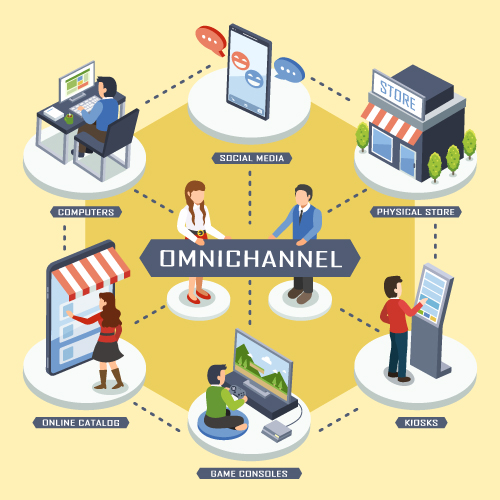What to do for a successful start?
The last blog post was about why your company should get into digital sales. This guide now revolves around the question "How can you get started with the digitization of sales?"
This question is not easy to answer. Because you have a variety of options for digitizing your sales and thus getting into e-commerce. Therefore, get an overview of the opportunities and risks, the measures and the challenges. And clarify a few essential questions in order to find the right solutions for your company. Let's start right away with the first question:
Who are your target groups? Which ones would you like to address as well?
Every strategy needs a goal and in our case also one or more target groups. Only if you know who you want to reach you are able to take the appropriate measures to digitize your sales. And you use it to derive which sales channels and distribution channels are possibly the best for your company.
Broadly speaking, you can address two target groups:
1.) Business customers
2.) Private customers
If you want to sell your products to business customers, you are active in B2B (business-to-business) and for the latter in B2C (business-to-consumer). Both customer groups can be addressed and reached differently in online retail.
How should digital sales work: B2B, B2C or D2C?
For B2B commerce, you have various sales channels in the digital sector. On the one hand, you can launch an online shop that offers special business-to-business functions. This includes, among other things, access for several authorized people per company, individual prices and the display of volume discounts. A direct connection to your business customers can also be established via EDI interfaces (Electronic Data Interchange). On the other hand, you have the option of selling your products digitally via special B2B marketplaces such as Amazon Business, Alibaba or WLW (Wer Liefert Was).
With B2C sales, you should decide whether you want to sell through sales intermediaries or directly to your end customers. That means: Do you offer your products via marketplaces and platforms such as Amazon, eBay, Otto or Zalando? Or are you trying to establish your own online shop where there are no “middlemen”? In this case you would be active in D2C (Direct to Consumer).
In summary, this means: In digital sales, determine how you want to sell your products. Are you looking to sell directly, through third parties, through online marketplaces, or a mix of all?
On how many channels do you offer your products?
Digital sales are booming. Nevertheless, it can make sense to maintain the classic sales channels. Then you should clarify: How many sales channels are there and how well are they connected? From this it can be deduced whether you are pursuing a multichannel, crosschannel or omnichannel commerce strategy. This means:
Multichannel
Multichannel commerce is the sale of products via different, non-interlinked channels. For example, your customers can't pick up products they order from your online store at a retail store.
Crosschannel
With a cross-channel strategy, you link different sales channels, for example via Click & Collect. But not all of your marketing, communication and sales channels mesh properly.
Omnichannel
Online shop, marketplace, retail store, social media, catalogues... with omnichannel commerce you serve numerous channels that are connected to each other. The boundaries between online and offline shopping are blurring.
Everywhere Commerce
If you optimize the omnichannel concept in such a way that your customers can purchase your products via every channel, so-called everywhere commerce is created. Aseem Chandra from Adobe once said: “Making every moment personal, every experience shoppable”.

How and where should customers be addressed?
Digital distribution is about breaking down boundaries. Otherwise it is not possible to implement a cross, omnichannel or everywhere commerce strategy. Eliminate your silo thinking. This includes, among other things, not just concentrating on your sales channels.
Successful sales require a stringent marketing strategy. Marketing feeds sales and sales feeds marketing. Accordingly, you should establish a so-called smarketing (sales + marketing)! Both departments must work together to develop a strategy for optimally addressing and converting interested parties at the numerous touchpoints of the customer journey.
Among other things, you can develop advertising campaigns together, exchange leads and synchronize your communication. And work on a common database, for example by having all customer contact information end up in a common CRM (Customer Relationship Management) system. Support can then also access this in order to enrich the customer information with further, useful data.
How can the high customer expectations be met?
Always be aware: the modern customer is volatile. He's constantly switching back and forth between online and offline channels. This ROPO effect (Research Online, Purchase Offline / Research Offline, Purchase Online) is not limited to B2C, it also exists in B2B.
In addition, there is the increasing “Amazonization of customer expectations”. What does that mean? Business customers are not robots, but people. People who want to buy the products they want just as quickly and easily in the office as they do in private life. Missing product and price information, complicated registration and purchase processes or long delivery times are equally a no-go in B2C and B2B.
If your company cannot meet these high and constantly growing requirements, your digital sales are in danger of becoming a flop. Always remember that your (potential) online customers only need a few clicks to buy from the competition!
Therefore, develop a digital strategy that you can use to create a positive, cross-platform customer experience. Only if you offer your target groups a good shopping experience from start to finish will they become customers and ideally also loyal regular customers.
How can a suitable e-commerce strategy be developed?
Don't make the mistake of thinking about technology first. You should worry about this point later. Instead, start at the very beginning as described: when defining the target groups and selecting the appropriate sales channels. And get as much feedback as you can to know exactly what your prospects and customers want.
Develop a medium-term mission and a long-term vision. So don't just think about the here and now, but about the future: Where do you want your company to be in ten years with its digital sales and e-commerce measures? Which sales channels could then be relevant for your customers, which less or not at all?
Also create an actual and target recording. Which systems, tools and processes are planned in your company? How suitable are these for realizing your project in the short and medium term? Where are still hurdles or problems? What marketing and sales activities do you still need to work on? Are structural things like changing your organization necessary?
Once you have clarified these points, it is time to work out the measures. In this context, it must be clarified which technical solutions you need. You will soon find out which ones are available and what you have to consider when choosing the right e-commerce technology in our blog.
Conclusion
Let's put it like it is: If your company is only now getting into digital sales, it has a mammoth task to solve. Certainly many of your direct and indirect competitors will already be active in cross- or omnichannel commerce. However, you shouldn't stick your head in the sand. Use your energy better to finally hit the ground running.
Develop a strategy that fits your target groups and your vision. Despite the pressure, don't rush things and take things one step at a time. For example, choose an agile approach by iteratively building your online business via an MVP (minimum viable product). And then stay tuned to reach your customers with their changing needs.








